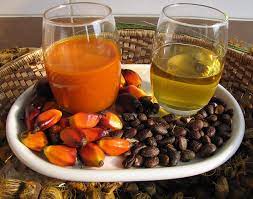PALM OIL :Constant exports provoke scarcity
Cameroon in recent years has been plagued with shortage in palm oil amidst rising demand. Despite the high demand for palm oil in the country, the little that is produced is rather exported to other neighboring countries in order to make more gains at the detriment of the population.
Cameroon palm oil export in 2019 was 13,244 tonnes; meanwhile, the demand for palm oil (processed category) witnessed a sharp increase that same year, fluctuating by 80.584% compared to the year 2018. Between 2017 and 2019, palm oil’s exports went up by 472.84% netting the nation US$9.31m for the year 2019. The diffferent categories of palm oil that are exported include: crude palm kernel and babassu oil, palm kernel and babassu oil and their fractions, whether or not refined.
In 2019, Cameroon sold palm oil costing 9.31m USD, a growth of 35.44% from 2018’s total palm oil export of 6.874m USD. The yearly growth in value of Cameroon palm oil between 2017 to 2018 was 107.548 pc. The annual variation in the volume of Cameroon’s palm oil exports between 2017 and 2019 was 472.84 % compared to a variation of 80.584% in the period between 2018 and 2019.
Between 2014 and 2018, Cameroon’s palm oil production recorded a notable rise from 343,000 tons to 413,000 tons, the ministry of agriculture revealed. Although Cameroon, the largest palm oil producer in Central Africa, produced close to 450,000 tons in 2020, it still imports about 60,000 to 100 000 tons every year to meet its domestic demand. Online portal, Business in Cameroon reported.
Most of the imported palm oil comes from Indonesia, Malaysia and Gabon. For several years, Cameroon has been faced with a predicament of: boosting oil productivity without jeopardizing sustainability. The paradox behind this all is the fact that the quantity of palm oil produced is not yet able to satisfy consumers, the population prefers to export to other countries. In the palm oil produced in the country was dedicated for domestic use only, it will go a long way to solve the oil deficit in the country. It is the same situation with the Ndop rice produced in the country. The quantity of rice harvested doesn’t meet up with the demand yet the population is still struggling to export rice to other neighouring countries. Is it that the local prices fixed for the sale of rice or palm oil by the ministry of agriculture doesn’t satisfy the traders or farmers? They have resorted to exporting in order to make additional gain at the expense of local population. As a result government is forced to import in order to meet up with the demand.
Palm oil is important to every household, given that majority of our traditional meals are prepared with the use of palm oil. Cameroon’s economy depends on commodity exports and global demand for its products which include oil, wood, rubber, coffee, cocoa, cotton and aluminum swings in world prices strongly affect its economic development and growth. Agriculture was the main source of growth and foreign exchange until 1978 when oil production boomed. Currently, agriculture contributes an estimated 20% to the GDP and about 70 % of the work force is engaged in agriculture and pastoral activities for their livelihoods.
Sandra Fomuso


